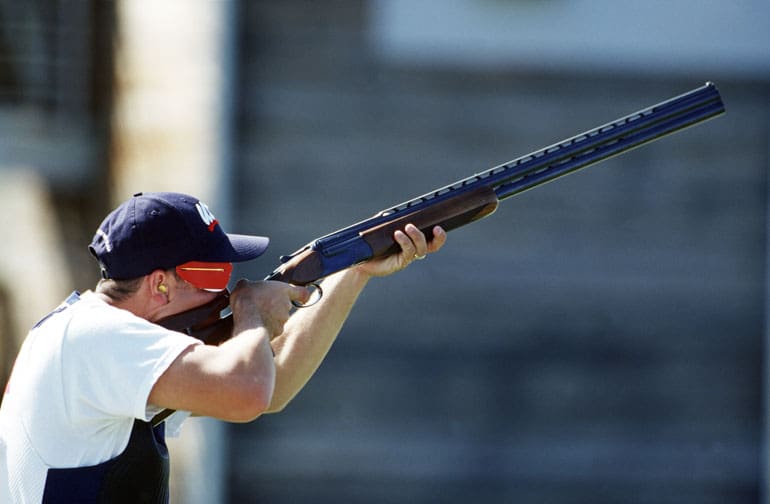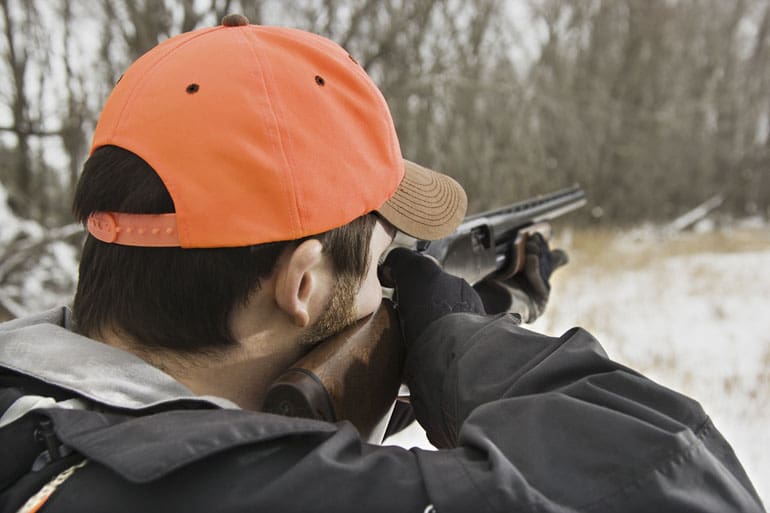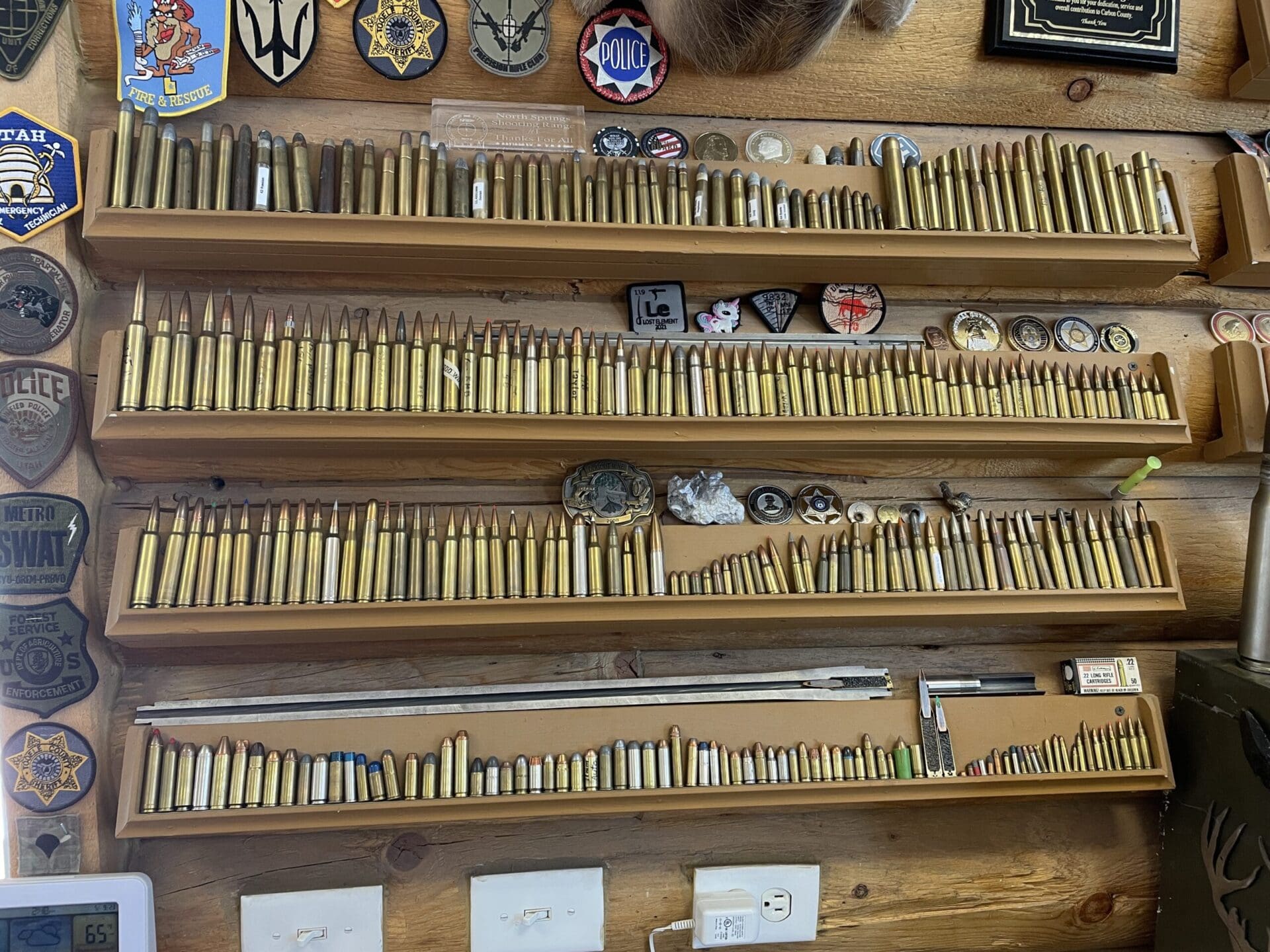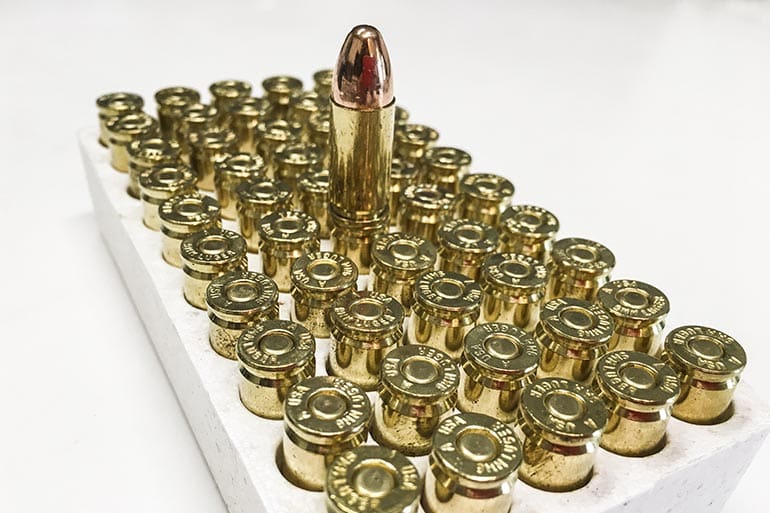Learning what is the correct way to shoulder a shotgun is a good idea, because otherwise you’re going to be in for a sore shoulder and you won’t want to ever shoot a shotgun again.
You can shoulder an AR improperly and it’s no big deal because shooting .223 is the BabyTown Frolics. A shotgun – say a 12-gauge, the most popular bore size – is more serious business and if you don’t shoulder it properly, you’re going to be in for some lively times. Not using a shotgun correctly will hurt more.

So… where to start?
A Gun That Fits
First is with a common mistake that many shooters make, which is not getting a proper gun fit or selecting a gun that doesn’t fit them to begin with.
Granted, there’s a difference between getting a workable fit and getting a custom fit. Most people can get “good enough” easily; the latter requires getting measured by someone who knows what he’s doing. Typically, you’ll only get a custom fit if you’re getting a bespoke double shotgun.

Also, my mall ninja amigos will be disappointed to learn that Holland & Holland doesn’t make a tactical model. Blue steel and wood shall be thy lot, and much shall be required to pay for one. But they sure do make a beautiful gun.
The utmost in precise fitment is a larger topic for another time. For now, we’re going to cover the basics. You can tell in a matter of seconds if a gun fits you, which is what we’re going to focus on here.
In the gun store, bring the gun up to your shoulder. Can you easily seat it in your shoulder pocket, or does it feel like the stock is too long or too short? If you feel like it comes up and seat easily and naturally, that’s good. A correct fit means that when you shoulder a shotgun, it sits firmly and securely into the shoulder. This actually minimizes recoil as you will feel MORE of it the more the stock moves.
Your shooting hand should be able to easily grasp the grip, and your trigger finger should comfortably rest on the trigger face. If you have to reach to get to the bang switch, that means your length of pull (how far you have to reach to the trigger) is too long. If you have to move your hand back to reach it, it’s too short.
You should be able to easily get your cheek down to the comb of the stock and get a decent cheek weld, your cheek resting comfortably on the stock. This matters, as you should be able to easily and quickly acquire a sight picture down the barrel. If you have to move your head or neck very much at all, it isn’t a good fit.
The rib and sight (usually a bead or – more common these days – fiber optic) should align on target. If the sight picture is wrong, the gun is wrong for you.
Pay attention to the grip itself. Can you easily get something like a firm handshake grip on the shotgun grip itself? Or do you feel like it’s too thick? If it feels too thick, it is.
Do you have to reach to get a good hold of the foreend, or does it seem like the gun mounts itself easily? If so, you have a winner. If not, you need to find a gun you can hold more easily.
Why does this matter?
If your gun doesn’t fit correctly, you won’t shoulder the shotgun correctly. You won’t shoot it well and it will not feel good to shoot…which will lead to buying another shotgun that DOES fit you well later on. Buy one that does the first time.
Stance
Next, the shooting stance…your shooting position. The classic shooting stance is to start by standing perpendicular to the target, with your weak side closest. Then, move your weak side foot to the side until it’s at about a 45-degree angle or a little shallower with your feet about shoulder-width apart or maybe a little wider.

Your back foot and strong side shoulder should be in line with your target, almost like in a boxing stance.
As you bring the gun up to your shoulder, bend your knees a little and lean into the gun. You should have about 60 percent of your weight on the front foot. This provides some push-pull – much like the classic Weaver stance – and helps with recoil management. As the gun comes up to the shoulder, you lower your head down to the comb of the stock and your strong-side eye (normally the dominant eye) acquires the sight.
In this regard, it’s much like classic off-hand rifle shooting, because it’s basically the same.
The butt should fit tight into the shoulder pocket, the space between the shoulder and the pectoral muscles. Again, if you shoulder a shotgun correctly, it won’t move much at all under recoil. It should be tight into the shoulder.
Your support arm elbow should be bent, with your elbow tucked into the body for proper support of the fore end of the gun. This provides a strong platform with which to shoot, whether your shotgun shooting includes pump-action shotguns, semi-autos or break-action guns.
Practice
The goal is for your body to hold the gun firm and stable. You’ll want to practice assuming the stance and bringing the gun up into a low-forward position, with the barrel below the line of sight. This way, you get your eyes on the target before bringing the gun up and getting the sight onto the target. This is something you can do at home.
Remember, being sure of your target is a must. It’s important at the range and is also a vital part of any hunting plan. Do you know the difference between a duck and a loon? Between a Canada goose and a brant? Just like needing to know if you’re looking at a buck or a doe that’s standing by some branches, you’d better be sure before you pull the trigger!
So, the proper way to shoulder a shotgun – any shotgun – is first to have a good fit, and you’ll know pretty soon if you have a comfortable fit. The proper stance will give the gun good support, and also enable you to shoot more comfortably, with good control and sight picture. You should be able to operate the shotgun smoothly and swiftly.
Practice shouldering the gun before hitting the range. If you get a good feel for it – which won’t take too long – then you’ll be in a better position to run the gun well.









This article reminded me of my first time shooting a shotgun, age 14. We had a forked fence post at the pond, Gramps showed me to lay the .22 single shot Iver Johnson on the forked post when shooting snakes and turtles. Worked good, okay enter my new gift a Rem model 10. I laid the shotgun in the fork, took a steady aim on a turtle( what’s with the no rear sight business ) kaboom, ow my forehead met the barrel. Went home and put the shotgun in the closet , because I didn’t want to look at that cannon no more.
Awe a Remington model 10. Yeah they kick as well as any pump gun and that’s quite a lot if you aren’t holding them just so. On a lighter note I love me some rem model 10. Gramps passed one down to me that has zero finish left on the metal parts and a stock I had to “fix” with some duct tape. They are pretty cool old scatterguns. I’d love to convert mine to a trench 10 someday. That would be old school cool.
Wow.
Great stuff Possum.
How are you now with shooting?
Target, critters, game, ?
We had horses we broke, I got back on that shotgun and learned how to ride. On shooting critters and such, I had a spiritual awaking yes I will kill a fly hut have gotten stung capturing and releasing a blue wasp that would have died in the window. May sound crazy to some, I’m okay with that. I hunt now through photography.
Very good.
You should figure out a way to post your photos if you haven’t already.
I, for one, love photos of wildlife of all kinds. Be it flora or fauna.
Indeed, I’m computer illiterate and not being a TTGA subscriber that may foul up some stuff? One of my favs is a cottontail on its back kicking off a red tailed hawk attack, right place right time and a while lot of luck
Pointed at the ground.
Always at the ground.
Always.
You’ll never win a gunfight with God.
Not if you’re hunting with my dog. We hold it upright. The dogs are running back and forth, up and down the field. Don’t trip.
Recoil is only one reason to make sure a shotgun fits.
Your success at putting shot on target is the other, more important reason. A gunsmith can solve recoil issues in a shotgun with all manner of technical fixes that won’t change how the gun points or mounts.
The way a shotgun points or mounts comes down to “does this gun fit you, such that every time you mount the gun, you get the same sight picture down the barrels?”
See, folks, the one important issue that people forget about shotguns is this: There is no rear sight.
I can hear a whole lot of people saying “Duuuuh… no shit… I didn’t need a gunsmith to tell me that.”
Yea, well, here’s the consequence of a shotgun not having a rear sight: Your eye is the rear sight. How your eye is positioned relative to the rib on a shotgun determines whether you will hit high/low, left/right.
The purpose of gun fitting is to give you a gun that truly fits you. When a gun truly fits you, you throw it up onto your shoulder, and clays (or birds) seem to fall out of the sky with no apparent effort. Suddenly, you “don’t know why,” but “you can’t seem to miss!” When you have a gun that really fits you, you can tighten up your choke, and still hit just as many clays in clay sports.
As for custom stocks:
“Typically, you’ll only get a custom fit if you’re getting a bespoke double shotgun.”
Not so. There are gunsmiths throughout the US who will make (as in, from a block of wood) and put a custom stock onto even a Remington 870, fit just for you. You’ll have to pay a bit for it, but that gun will now fit you.
You could also get an adjustable stock, with recoil buffers built in. Something like this, for example, which is popular with lots of folks in the trap world:
http://www.precisionfitstocks.com
No wood at all.
If you’re good enough with the software, you can actually 3D print your own stock as well. Build area remains an issue on a lot of the lower-priced printers, but you could either do it in pieces or design some kind of inserts to the existing stock to get the same effect. I don’t know that I’d want to go to war with something like that, but for sporting use it’d hold up just fine, and there’s no reason why you couldn’t print a just-in-case spare as well.
Great information as usual DG!
BETTER than the article!
There’s nothing wrong with the original article. It’s all true (modulo the bit about stocks and bespoke guns).
The central point I have to hammer home to customers is this: A gun that fits, and I mean really fits is one that seems to “leap to your shoulder,” “just feels right,” “I don’t feel the recoil any more,” and my favorite “I can’t seem to miss.” Lots of people have a difficult time verbalizing how much they like a stock that truly fits them – because until they had one, they had no idea how much better they should shoot, or how much more enjoyable shooting could be.
The biggest thing about shotgun fit is that you want to get the same sight picture every time you mount the gun. The gun should fit you so well that you know, immediately, when the mount isn’t correct. You can feel that you’re holding the gun incorrectly, as quickly as you know you put your left boot on your right foot. If you’ve never had a stock/gun that truly fit you, then you don’t know what a correct fit feels like – because you’re constantly contorting yourself, modifying your mount, etc – to make the incorrect fit work. You simply don’t know better.
Now, on a rifle, because it has a rear sight (or a scope), as long as you get the sights to line up, or the scope to collimate, you’re going to put the round on target (or damn close). If you have to contort your mount, well then, so be it. It will be uncomfortable, it might hurt if you light off a heavy-recoil rifle because it isn’t mounted as well as it could be, but you should put the round on target. So in your estimation “it works. It isn’t fun to shoot, but it works.”
Not so with a shotgun, and even more so because in shotgun shooting, you’re typically moving the gun, and you’re moving your upper body to follow the target. If the gun didn’t fit when you were holding the gun static, the fit usually ain’t about to get better when you start your swing.
When a gun fits, and I mean really fits, and you shoot clay sports quite a bit, you move on from the level where you’re swinging on the bird, and instead, you call for the clay, you see the clay, you mount the gun, and you break the clay – all in one smooth motion. You actually mount the gun with the lead factored in – but you’re not really swinging the gun. When you have a gun that fits, this happens faster, with better results, than if you work at compensating for a mis-fit gun for years, and you’ve just attained a level of adaptation where you know to mount the gun like “X” to get the results. You might not like the fit, but you’re not doing anything about it because you’ve never mounted a gun that truly fits you.
It’s like owning a pair of made-just-for-you custom boots (eg, cowboy boots). Until you’ve owned a pair of handmade boots where your feet were really measured, you have no idea that such boots could feel better than bunny slippers on your feet. I have such a pair, and my wife has to pry me out of them. They’re comfortable – why do I want to wear something different?
Same deal with shotguns. When you have a gun that fits, suddenly, it is as though the skies opened, the clouds parted, and one of those big arrays of trumpets came down from the heavens and started blowing sweet melodies – like something straight out of a Monty Python short.
Now, one more comment: Many newer/younger shooters in the age of the AR-15 being the most popular rifle in the market, have NO idea how even a rifle stock is supposed to fit. These poor shooters have come into the gun world when we’re in a retrograde period of gun fitting – the AR-15 has to be one of the worst designed firearms from the standpoint of stock fit. The AR sucks rocks up off the ground, it’s so bad in the stock/mount department. But lots of people like their AR’s and they’ve found a way to make them work… because they have rear sights on them (or optics). They really don’t know any better, and hey, since they’re putting rounds on target, the fit is “good enough,” because putting rounds on target “is what this is all about, right?”
Shotguns need to fit. Maybe the “tactical” shotguns don’t, but a real field or clays shotgun needs to, if you’re going to shoot to your potential.
I have quite a number of shotguns. My favorite for fit is an old Fox Sterlingworth. 12 gauge, bakelite buttplate, splinter foreend, no ejectors. This gun fits me so well that I can smoke clays out of the air for perhaps 15 out of 25 clays on a trap range – and I might miss only one or two birds out of the 25. When I say “smoke,” I mean that the Improved Modified choke keeps the shot column very tight at trap ranges, and the clay turns to dust in the air. It means I put that shot column exactly onto that bird. The rest of the clays break into little pieces, but you can see the pieces after I’ve hit it.
Put a Beretta or Browning Citori in my hands and I’m all over the place. Give me my Sterlingworth (with IM and Full chokes) and I can smoke clays. The limiting factor is how the splinter foreend doesn’t give me much to grip when the barrels get hot – so I have to wear a glove to shoot more than one round of trap. You can bet I’ve got the measurements of that Fox stock recorded, and that’s what I use as a starting point when making a custom stock for myself.
This explains why my silver pigeon points and shoots better than my M1 tactical.
I don’t miss with my silver pigeon.
I miss all the time with my M1.
I had no idea.
Thank you sir!
i’ll pull the stock in from the pocket just onto my pectoral. less pain.
All good stuff. However, for the novice or someone struggling with the scattergun, a reminder that we do not aim a shotgun- we point it. Even with the proper fit, it’s necessary to put the shot where the target is going to be when they intersect.
My old man was a small bore competitor in his younger days. He could knock squirrels out of a tree or hit about anything with a rifle but he never got the pointing thing mastered. He’d marvel at me shooting trap in a league during the summer, watching the black puffs. I’d marvel at him splintering hunk of a branch at about 225 yards, off hand with his old 1917 Enfield.
I was struggling last summer in the trap league until I finally got back to the basic of bringing the gun into that pocket of the shoulder. I was a bit outside, the entire sight picture didn’t look right and the result was too much side to side regardless of my cheek and eye. I don’t shoot trap when I come back from the summer, next year I’ll go back to the basic mounting for a bit.
Again, good article.
Whatever way gets you the desired results. There is no right way only opinion.
This is next to the article on the Mossberg shockwave 12ga. Ha ha.